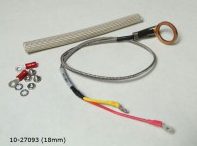It takes only a very small leak past the baffle seals to screw up the CHTs – see the thread on baffle seals. By re-doing them in the proper PTFE-coated stiff material brought CHTs down from 400+ (on a warm day; 440 when departing in Greece at +35C) down to about 360.
@UdoR , you are correct that too high a temperature as well as too low is bad for your cylinders.
The problem with low temps is that lead salts and other deposits do not get cleaned up and accummulate, leading to exhaust valve leaks, guide wear and eventually burned valves as well as other problems, especially on Contis.
The problem with high temps is the metallurgy of the aluminum heads is such that they weaken significantly above around 400F leading to eventual cracking.
On Contis you should aim to always be above 300F and below 400F. Ideally 350F-390F depending on sources and depending on how and where you measure. I think Lycos should be similar, although they usually have a higher CHT limitation.
The challenge for low temps is of course descent: how do you keep it warm enough? A short while at 250F will not hurt your engine but if you do a long descent at 500fpm from 20000ft (that is 40 mins!) at 250F that is bad.
The challenge for high temps is of course climb as well as cruise. ROP you should be rich enough to ensure <400F, LOP you should be lean enough to ensure<390F
In order to be able to have good management of your temps you need to start from good baseline data:
Distilled water boiling at 212F at SL is a known reference for single-point verification of your probes. Immersing them in boiling distilled water should indicate around that. Just don’t get burned while testing it please (don’t ask me how I know of that risk).
I used to have spring-loaded JPI probes on the cylinder of my former IO360 and they were very accurate. Are those the same type that your O-540 uses?

Perhaps one cylinder is using the spark plug washer JPI probe since the OEM probe occupies the orifice on the head ?

If so then that cylinder would tend to indicate differently on t he JPI vs the other cyls.
If all is correct and you have the right type of probes, then crud inside the cylinder head probe orifice or different spring tension may be affecting reading. Make sure the orifice is clean and the probe is correctly torqued.
As indicated by @Malibuflyer, 50% power is a very low power setting and CHT should be well in control. You should be able to fly 65% or more LOP without CHT control issues. 65% power is in fact better for your engine than 50%: keeps it cleaner and piston rings properly seated!
The excellent Pelican’s Perch series on Avweb by John Deakin has quite a few articles on engine management that you would enjoy reading and get a wealth of engine management info from
Yes thanks for all the input. I’ll check it out.
A couple of pics of how baffling should look like on a Comanche, I guess similar to how yours should look like


The orange parts are the flexible seals. The ones you cannot see in this picture are equally important:
-The inter-cylinder metallic baffles
-The baffle sealing with the forward cowling bowl
Antonio wrote:
I guess similar to how yours should look like
No, it’s not even near similar. Thanks for sharing, but the air flow beneath the turbo cowling is really quite totally different. It is not only that the Tiger shark cowling of the “C Comanche” already has a different airflow to what looks like a B Comanche in the pictures, the Turbo needs a separated air flow for air intake and that goes right from the inlet over the cylinders. On the other side of the engine is another portion of airflow directed on the oil cooler which sits on the firewall. So yes, I know what baffles and seals are and how they should perform. We won’t solve that here. I have to inspect my baffles and seals and do whatever might be necessary.
Antonio wrote:
I used to have spring-loaded JPI probes on the cylinder of my former IO360 and they were very accurate. Are those the same type that your O-540 uses?
Yes those look quite similar to what I have installed.
I might add that according to my information here Lycoming states that the metallurgy of my engine differs from other engines, so that it may be run hotter by at least 35°F.
Aha! 260 TC nice! Then all the info on baffling should be in the OEM documentation.
I’m glad you know how baffling works. You’d be surprised at the number of aircraft out there with reversed or missing baffle seals or inter-cylinder baffles.
Then your engine layout must be closer to this


But this one has the oil cooler on the bottom rh of the latter pic